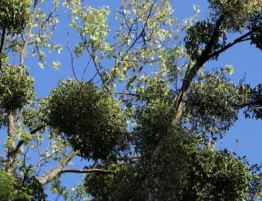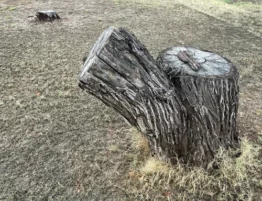You can’t look at a Mesquite tree here in the Abilene area that has lost leaves without seeing the green sprouts of mistletoe. Folks who are experiencing their first Christmas in the area may not realize how common it is in this part of the world. They probably don’t even know it’s mistletoe…

The tradition of mistletoe during Christmas dates back to ancient times and has pagan origins. Mistletoe was considered a symbol of fertility, peace, and love in Celtic and Norse mythology. It was believed to have magical properties and was often hung in homes for good luck and protection.
During the Roman festival of Saturnalia, which took place around the winter solstice, mistletoe was exchanged as a symbol of friendship and goodwill. It was also associated with the Norse goddess Frigg, who was said to have declared mistletoe a plant of love and promised to kiss anyone who stood beneath it.
Over time, the tradition evolved into what we now know as “kissing under the mistletoe.” It became a popular Christmas custom in England during the 18th century. According to the tradition, a couple standing under the mistletoe is supposed to exchange a kiss, and it’s believed to bring good luck and happiness to the couple.
Today, hanging mistletoe is a common Christmas decoration in many homes, and the tradition of kissing under it remains a playful and festive custom during the holiday season.
Mistletoe is actually a type of parasitic plant that grows on various trees, including apple, oak, and pine trees. It’s known for its distinctive evergreen leaves and white berries. There are several species of mistletoe, but the European mistletoe (Viscum album) and American mistletoe (Phoradendron spp.) are the most commonly recognized.
This plant is unique because it doesn’t root in the ground like most plants; instead, it grows attached to the branches of host trees, like you see it here in West Texas, where it extracts water and nutrients from the trees.
Some great tips on using it for holiday decorating and making your own decorations may be found here.
Whether seen as a blessing or a curse, mistletoe doesn’t spread rapidly. Its growth rate is quite slow, extending only about 2 feet per year. Research suggests that it takes roughly 60 to 70 years for a 1.5-acre area of mistletoe to develop. Similarly, the demise of a single tree due to dwarf mistletoe could take several decades, and an extensive infestation over a large amount of acreage might occur over centuries.
Though mistletoe berries can be poisonous if ingested, the plant has been used in traditional medicine for its potential medicinal properties. In modern times, it’s primarily known for its decorative use like now during the holiday season, where it’s hung as a decoration, and the tradition of kissing under it is observed in some cultures.
Mistletoe And Tree Care
Mistletoe can indeed have detrimental effects on your live oak trees and other host trees. As we mentioned, it is a parasitic plant, mistletoe attaches itself to the branches of trees and extracts water and nutrients from the host. This extraction weakens the tree, affecting its growth and overall health.
In the case of severe infestations or when the tree is already stressed due to other factors like the drought conditions we’ve experienced the last couple of years or disease, mistletoe can exacerbate the tree’s decline. It can lead to stunted growth, branch dieback, and in extreme cases, it might contribute to the eventual death of the host tree. You can contact our tree service professionals to come out and assess your trees. Wintertime is a great time to have us visit as we can see the entire tree without the leaves.
The impact of mistletoe on a tree can vary depending on a variety of factors including the tree’s overall health, the extent of mistletoe infestation, and the specific species of mistletoe involved. Regular pruning of infected branches and managing the mistletoe can help mitigate its impact on the tree’s health.








